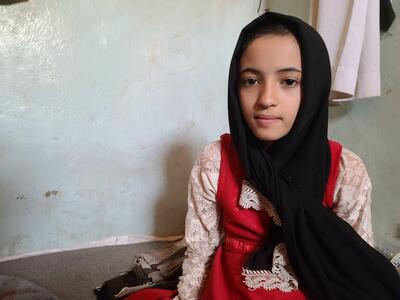2021年11月30日
The number of children living in deadliest war zones rises nearly 20% to highest in over a decade
New analysis also reveals more than 330 million children at risk of recruitment to armed groups and government forces worldwide—three times more than in 1990>
Tagreed*, 11, was injured and lost one of her legs when she was hit by a missile in July 2019 in Saada, Yemen.
Nearly 200 million childreni are living in the world’s most lethal war zones,ii the highest number in over a decade, many of whom are already at risk of climate change and facing unprecedented levels of hunger, a new report from Save the Children reveals.
Save the Children’s sixth report examining conflict trends for children found that the number living amid lethal conflicts in 13 countries rose nearly 20% in 2020 from 162 million a year earlier—making it the second highest number on record, just behind 2008 at 208 million. The sharp increase in 2020 shows that a global pandemic and United Nations’ call for a global ceasefire were not enough to halt these wars.
This spike was driven partly by outbreaks of violence in Mozambique, as well as ongoing conflicts in Afghanistan, the DRC, Nigeria, and Yemen, which are already on the frontline of climate change’s worst impacts and coping with life-threatening hunger crises. The report, “Stop the War on Children: A Crisis of Recruitment”, also revealed that 337 million children were living near armed groups and government forces that recruit children, a threefold increase from three decades ago (99 million in 1990). The number of countries where children are recruited—and where more than half the world’s children (nearly 1.3 billion) live—also jumped to 39, its highest in 30 years.
According to the new analysis, Afghanistan,iii Syria, Yemen, the Philippines, and Iraq have the highest percentage of children living near an armed group or force that has recruited children, leaving them at greater risk of recruitment.
Poverty and not being able to attend school — factors that have only worsened with the pandemic — are among the reasons why children are more vulnerable to recruitment by armed groups and forces, where their duties can range from fighting on the frontline to manning checkpoints. Many are also drawn to such groups in search of a sense of belonging, protection from abuse, status, or revenge.
While girls only made up 15% of UN-reported cases of recruitment in 2020, they are often targeted to act as spies, to lay mines and improvised explosive devices, or to act as suicide bombers because they are less likely to draw attention. Their vulnerability, low status, and gender also makes them susceptible to widespread abuse.
Children who are used by armed groups and forces are at greater risk of injury, disability, chronic mental or physical illness, PTSD, sexual violence, and death.
“We were at the river swimming when people took us into the forest by force. They tortured us, beat us, and taught us how to kill and kidnap people. We have suffered a lot,” said Jean*, 17, who was forced to join an armed group in the Democratic Republic of the Congo before being rescued by Save the Children’s partner organisation, KUA. “When I was in the forest, I felt very bad. I was very scared. My life was difficult.”
Inger Ashing, CEO of Save the Children International, said:
“It’s simply horrifying that in the shadow of COVID-19 and the UN’s call for a global ceasefire, more children than ever before are caught in the crosshairs of the deadliest war zones—where they’re already facing more droughts, floods, and hunger—and more likely to be injured, recruited or killed. Not even a global pandemic was enough to stop the most brutal wars and atrocities.
“Millions of children have known nothing but war with appalling consequences for their mental health, ability to go to school, or access to life-saving services. This is a stain on the international community and cannot go on.
“We know we can tackle the greatest challenges of our time and achieve remarkable progress when we work together, like the recent development of COVID vaccines. We now have to do the same to protect children from the horrors of conflict.”
The report also reveals that:
- More than 450 million children worldwide—or 1 in 6—were living in a conflict zone, a 5% increase from 2019, and the highest number in 20 years. The number of conflicts in 2020 was identical to those in 2019.
- The number of armed groups recruiting children rose during the pandemic to 110, compared to 85 in 2019.
- The UN verified nearly 8,600 cases of recruitment and the use of children in 2020—roughly 25 a day—despite the global pandemic, a 10% increase from the previous year. These numbers, however, are likely to represent only a fraction of actual cases.
- Interviews with 40 Save the Children staff members in 14 countries and regions about the situation for children found that:
– Many children have only known conflict, with serious impacts on their mental health;– Children in conflict are bearing the brunt of weakened or collapsed economies and a lack of access to basic services, which has only worsened with COVID-19;
– Rarely is anyone being held accountable for atrocities committed against children;
– Access to education—often one of the first casualties of war—is equally critical to protecting children from conflict-related risks like forced recruitment.
Among its recommendations, Save the Children is calling on world leaders, security experts, donors, members of the UN, and NGOs to work together to hold perpetrators of these violations to account, to ensure all relevant policies and legal frameworks are ratified and implemented, and to ensure donors and governments prioritise child protection funding in humanitarian responses—which is at an all-time low—to support children impacted by conflict, including those who are recruited.
For detailed report, please click here.
*Name changed to protect identity


